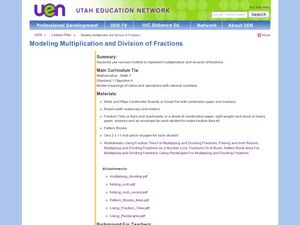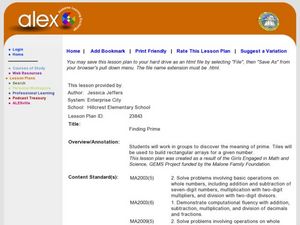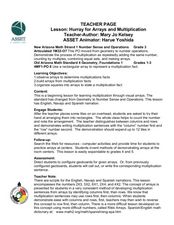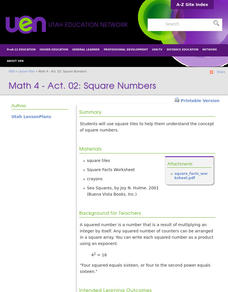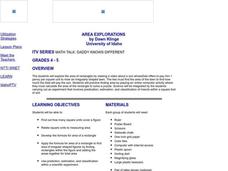Curated OER
Modeling Multiplication and Division of Fractions
Create models to demonstrate multiplication and division of fractions. Using fraction tiles to model fractions, pupils explore fractions on a ruler and use pattern blocks to multiply and divide. They also create number lines with fractions.
Alabama Learning Exchange
Finding Prime
Fifth and sixth graders explore prime numbers. They work with a partner to build rectangular arrays using twelve tiles. Factor pairs are noted and recorded on graph paper. Pupils construct rectangular arrays with a prime number and...
Curated OER
Hurray for Arrays and Multiplication
Third graders begin learning about multiplication using arrays. In this multiplication with arrays lesson, 3rd graders interact with tiles on the overhead as they follow the teacher in making arrays. They write multiplication sentences...
Curated OER
Distribution Property Of Multiplication Over Addition
Fourth graders complete problems where they demonstrate their knowledge of the distributive property of multiplication. For this distributive property lesson plan, 4th graders are provided with worksheets.
Curated OER
Square Numbers
Fourth graders use square tiles to help them explain the concept of square numbers.
Curated OER
Complexity Madness
Discuss different techniques for finding the area of a geometric shape, with a great visual guide. Using a real life example, learners calculate the area of a rectangle and a square.
Curated OER
Prime Numbers and Factors
Students determine factors of numbers to 100 and identify prime factors; students differentiate prime and composite numbers by the factors of the numbers.
Curated OER
Area Explorations
Students explore the area of rectangles. They practice finding area by playing an onliine computer activity where they calculate the area of a rectangle to solve a problem.
Curated OER
Disappearing Magic Factors
Students identify, through the number of rows and columns, the factors related to the product. In turn, they also discover how to find the missing factor, which is part of the fact family for that product.
